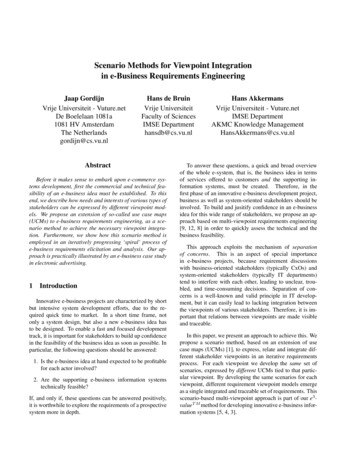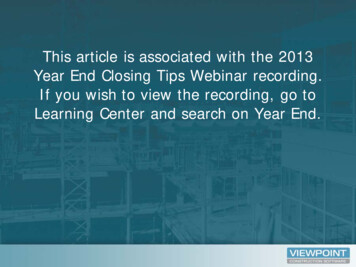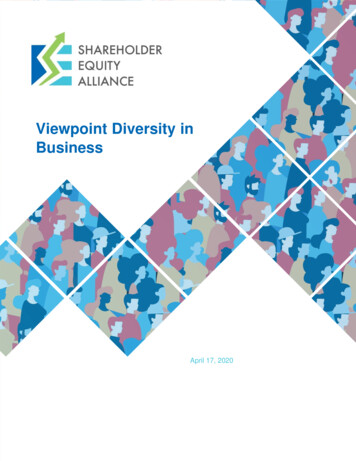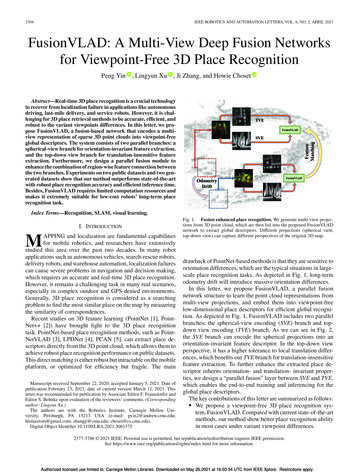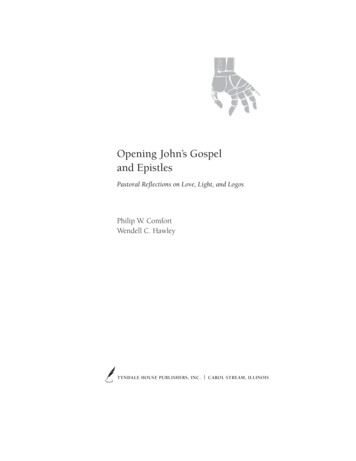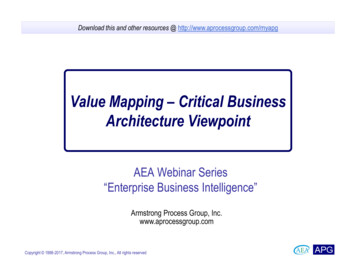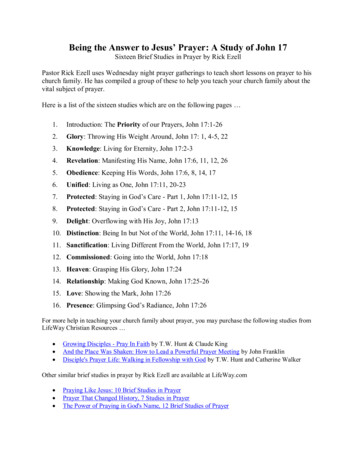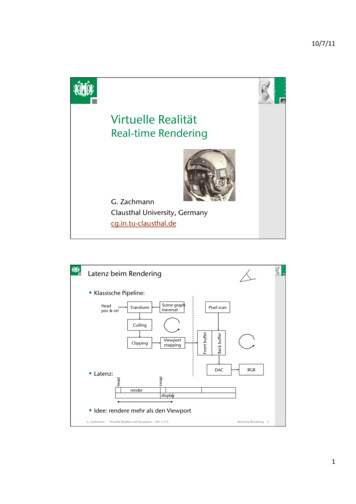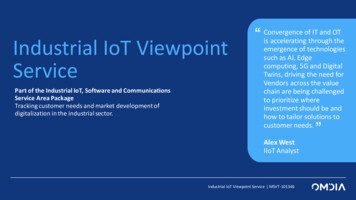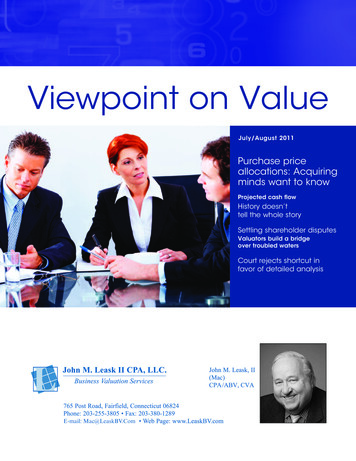
Transcription
Viewpoint on ValueJuly/August 2011Purchase priceallocations: Acquiringminds want to knowProjected cash flowHistory doesn’ttell the whole storySettling shareholder disputesValuators build a bridgeover troubled watersCourt rejects shortcut infavor of detailed analysisE-mail: Mac@LeaskBV.Com
Purchase price allocations:Acquiring minds want to knowWhen planning to merge with or acquireanother company, a business owner needsto identify what’s actually being sold andestimate what those assets are really worth. Oftenthe most valuable assets — such as goodwill, brandnames, customer lists and patents — don’t appear onthe balance sheet.A preacquisition purchase price allocation helps anowner determine whether a purchase price is reasonable. In addition, how the purchase price is divviedup on the acquirer’s balance sheet has an impact onfuture earnings — thus affecting the transaction’sperceived success.Identify the assetsUnder Generally Accepted Accounting Principles(GAAP), companies that merge with or acquireanother must allocate the purchase price amongthe assets and liabilities acquired according toAccounting Standards Codification (ASC) 805(formerly covered by Statement of FinancialAccounting Standards No. 141R).The first step in any purchase price allocation is toidentify all tangible and intangible assets includedin the deal. Examples of tangible assets are accountsreceivable, equipment and inventory.To help categorize identifiable intangible assets, ASC805 provides a framework based on whether the assetis related to: Marketing (trademarks, noncompete agreements,Internet domain names), Customers (customer lists, production backlogs), Artistic practice (copyrighted books, articles,photographs), Contracts (royalty agreements, franchises, leases,employment contracts), or Technology (patents, trade secrets, in-processresearch and development, computer software).The acquirer must estimate a useful life over whichto amortize each intangible asset. But some intangibleassets, such as brand names and in-process researchand development, may have indefinite economic lives.These are tested at least annually for impairment.(See “Inaccurate allocations strike back” on page 3.)Estimate the cash-equivalentpurchase priceThe next step is to evaluate the total consideration tobe paid for the company. Purchase price is obvious inmany transactions. But the waters are muddier when2
Inaccurate allocations strike backValuing intangible assets is not a one-time exercise. Accounting Standards Codification (ASC) 350(formerly covered by Statement of Financial Accounting Standards No. 142) requires companies totest goodwill and other indefinite-lived intangible assets at least annually for impairment.Impairment testing is a two-step process. First, the company (or reporting unit if there are multipledivisions or product lines) is valued. If the book value of the reporting unit is more than its fair value,impairment has occurred.Next, fair value is allocated among the reporting unit’s assets and liabilities. This exercise is similar to apurchase price allocation under ASC 805 (see main article). The unallocated portion of the fair value isattributed to goodwill. The difference between the fair value of an intangible asset and its book value iswritten off as an impairment loss.Sloppy, do-it-yourself purchase price allocations may result in future impairment losses, which, in turn,raise a red flag to lenders and investors. An experienced valuation professional can help get intangibleasset valuations right the first time around.private stock is exchanged, an entrepreneur signs anoncompete or employment agreement, contingentliabilities exist, or part of the selling price is contingent on future earnings.A valuator can help convert these payment termsinto a current cash-equivalent price and separate outpersonal payments to shareholders from the amountpaid for business assets — a prerequisite to accuratepurchase price allocations.Value the assetsNow comes the heart of the purchase price allocation:valuing the assets. Book value may be a reasonableproxy for many tangible assets, including marketablesecurities, receivables and inventory. A real estate ormachinery appraiser can help with fixed assets.Intangible assets, while increasingly important intoday’s knowledge-based economy, are more complex and difficult to appraise. ASC 805 recommendsusing the market approach to estimate the fair valueof intangible assets, because it relies on actual markettransactions. But in practice, the market approachmay be difficult to apply due to the special natureof intangible assets as well as the lack of comparabletransaction details.Instead, valuators often opt for the cost approachor the income approach. Under the cost approach,fair value equals the cost to reproduce or replace theasset. This approach is most relevant for internallygenerated intangibles, such as software or secretformulas.More common is the income approach, which basesvalue on an asset’s future economic benefits. Forexample, the relief-from-royalty method derives valuefrom the cost savings of not having to pay a royaltyfor use of the intangible asset. Alternatively, valuatorssometimes perform discounted cash flow analyses,in which an asset’s cash flows are projected and thendiscounted to their net present value.Intangible assets, whileincreasingly important intoday’s knowledge-basedeconomy, are more complexand difficult to appraise.When using the income approach, the valuator typically avoids double-counting one income streamfor two (or more) separate intangible assets. Additionally, he or she ensures that discount rates arecommensurate with the risks of the intangible asset,not necessarily the acquirer’s overall discount rate.3
Assign the remainder to goodwillAfter the appraiser has allocated value amongidentifiable assets and liabilities, the remainder iscategorized as goodwill. Goodwill has an indefiniteuseful life. Therefore, it is no longer amortizedunder ASC 805.The recession has forced some businesses to sell atbargain prices. In these cases, the combined amountallocated to the acquired assets may exceed the purchase price. Rather than record negative goodwill,the acquirer records a one-time gain at the time ofsale under ASC 805.Pay attention upfrontToo often an afterthought, purchase price allocations should be premeditated. Before embarking on amerger or acquisition, business owners and their legaladvisors should work with a valuation professional toensure the transaction makes sense from a financialreporting perspective and to eliminate unpleasantpostdeal surprises. lProjected cash flowHistory doesn’ttell the whole storyArational investor would never buy an assetwithout a reasonable expected return. Aninvestment’s value is based on what economicbenefits — whether in the form of dividends, interestor cash flow — it’s expected to generate in the future.Projected cash flow is thus an important measure offuture economic benefits.And a business’s historic cash flows may not be anaccurate measure of its expected future performance.Some businesses — such as a mature, stable companythat manufactures a product undifferentiated from itscompetitors with an easily foreseeable demand and aknown market size — may grow at a relatively constantrate. But, especially in an uncertain business climate,most companies experience significant changes eachyear as they progress through product life cycles, adaptto changing technology and move into new markets. Asa result, they don’t grow at constant rates. That’s why acash flow projection can be valuable.2 methodsWhen projecting cash flow, a valuator generally usesthe income approach, which involves one of the following methods, depending on the circumstances:41. Capitalization of incomemethod. If a company’s historiccash flows are likely to continue,and its growth rate appears relatively stable, a valuator might usethe capitalization of incomemethod. This method is moreappropriate when the economicbenefits (net income and cashflows) are fairly constant and areexpected to continue to be so inthe future. It employs an expectedconstant risk (capitalization) factor.2. The discounted cash flow orearnings method. If a valuatorcan’t use historic cash flows as aproxy for predicting future performance, or can’t expect the growthrate to remain relatively constantover time (literally, into perpetuity), a discounting method willmore accurately determine thebusiness’s value. The discountedcash flow or earnings method
recognizes that a dollar today is worth more thanone received in the future, and discounts a company’s projected earnings to adjust for real growth,inflation and risk.Variables a valuator considers include whetherthe base period financial position (usually the current year) is a representative year, whether thecompany’s future performance is expected to be acontinuation of established trends, and whether theprojection period should be three, five or 10 years.(For a cyclical business, the forecast must incorporate a full cycle.)In addition, the discount rate, along with the timingof future cash flow, provides the present value of cashflows or earnings over the life of the business and hasa large effect on the valuation. Careful analysis of theappropriate discount rate is essential.Profit vs. cashExperienced business owners know that profits meannothing if there isn’t enough cash left over to paytheir salaries and dividends. A common questionfrom frustrated business owners is: Why does myprofitable business frequently seem on the brink ofa cash crisis? Although normally desirable, growth isoften the culprit.For instance, the cash operating cycle is the amount oftime it takes a business to convert raw materials intocash collections. The clock starts ticking as soon asinventory is purchased, continues running during themanufacturing and billing processes, and stops whenthe customer pays the invoice. Unfortunately, mostbusinesses receive payment from customers long afterthey’ve paid for key operating costs, including salaries,rent and supplies. The lag between cash expendituresand cash receipts can cause a cash shortage, if notproperly planned for. Higher growth rates and longercash operating cycles compound cash shortfalls.Valuation experts have morein their bag of tricks than theability to appraise a businessinterest.Cash flow projections can help owners manage cashflow more efficiently and survive the monthly (oroff-season) cash crunch. Unlike accountants — whotend to communicate in terms of balance sheets andincome statements — valuators appreciate the rolethat cash flow plays in driving shareholder value.They can help explain complex business concepts interms of their effects on cash.Beyond the purpose of a valuation, a valuator’s cashflow projection can serve as a useful planning tool,helping management prepare cash flow budgets,evaluate strategic investment decisions, devisereorganization strategies, and brainstorm profit andefficiency enhancement alternatives.Valuation bag of tricksValuation experts have more in their bag of tricksthan the ability to appraise a business interest. Aspart of their professional training, valuators learnhow to project cash flows and to calculate the present value of those cash flows using an appropriatediscount rate. This expertise makes them uniquelysuited to help management increase efficiency andprofitability. l5
Settling shareholder disputesValuators build a bridge over troubled watersAcompany’s owners tend to get along whentimes are good, but economic downturns canbring out the worst in shareholder relations.For instance, minority shareholders might suspectcontrolling shareholders of withholding dividends orfinancial information. Siblings might disagree aboutthe appropriate strategy for their family business.Or a creative partner might violate his noncompete agreement by diverting intellectual property toanother business in which he’s the sole owner.Valuators can help settle shareholder disputes —both in and out of court — allowing the remainingowners to refocus their attention on building andpreserving value.Case in pointLet’s look at a fictional scenario representative ofmany real-life ones that have been playing out overthe last couple of years: When Felix and Oscar wentinto business in 2000, they thought it was a perfectmarriage. Felix, who was disciplined and organized,handled finance, production and human resourceschores. Creative and charismatic Oscar focused onproduct development, marketing and sales. Everything ran smoothly until the recession caused thecompany to miss its sales and profit goals.Oscar decided Felix’s conservative ways werehampering growth. Felix accused Oscar of lavishR&D and entertainment spending. Their constantbickering caused several key managers to resign.Both partners wanted to dissolve the company butcouldn’t agree on buyout terms.Their attorney recommended hiring a valuation professional to sort out the details. The first step was anappraisal. The valuator analyzed future cash flowsand provided several real-life comparable transactionsto support her estimate. Then she provided recommendations regarding the timing and structure of apotential buyout to maximize cash flow, minimizetaxes and comply with the shareholder agreement.Felix and Oscar were surprised to discover that, inthe current economy, their business wasn’t worthmuch more than book value. After objectively evaluating the facts, the frustrated owners decided it mademore sense financially to stay “married.” Leveragingthe valuator’s industry know-how and her financialanalyses, the partners compromised and collaboratedto achieve a mutually agreeable turnaround plan.Today, the business is on the road to recovery.Irreconcilable differencesOf course, not all shareholder disputes end on a positive note. Sometimes owners contemplate legal action.A valuator can help determine whether it’s financiallyfeasible to pursue a case. Hiring a valuator as soon inthe process as possible improves the efficacy of discovery, increases the likelihood of out-of-court settlementand provides adequate time for the expert to perform acomprehensive analysis.6
Valuators often serve as expert witnesses in shareholder litigation. A valuation expert might providetestimony concerning: The fair market value of the business, includingthe fair value of each shareholder’s interest, Economic damages, including temporary lostprofits and diminution in business value, Formal rebuttal of an opposing expert’sconclusions, Reasonable compensation for shareholderemployees, and Appropriate discounts for lack of control and marketability, depending on relevant legal precedent.A valuator also may serve as consultant, helpingthe attorney critique the opposing expert’s reportand prepare questions for deposition and trial. Buta valuator shouldn’t serve as both expert witnessand consultant on the same case. Keeping theseroles separate helps prevent a valuator from beingperceived as a “hired gun” by judges, juries andmediators.Unbiased supportShareholders often butt heads, whether it’s aboutpast events or a business’s future direction. Whendifferences of opinion impair performance, it’stime to call for professional advice. Valuators areobjective outsiders who can defuse emotions andrefocus the parties’ attention on the cold, hardfinancial facts. lCourt rejects shortcutin favor of detailed analysisA common rule of thumb for calculating reasonable royalties in patent infringement cases has beento presume the inventor and manufacturer split pretax profits 25/75. But now in Uniloc USA Inc. v.Microsoft Corporation, the U.S. Court of Appeals for the Federal Circuit called this methodology“fundamentally flawed.”The case arose when Uniloc alleged that copy-protection features of certain Microsoft productsviolated Uniloc’s patent on a registration system that deters unauthorized copying of software.Uniloc’s expert based his damages calculation on a prelitigation Microsoft document that valued thecopy-protection feature between 10 and 10,000, depending on usage. The expert applied a 25%profit split to the bottom of this range, yielding a “reasonable royalty” of 2.50 per product sold. Basedon the expert’s methodology, the trial court awarded 388 million in damages.The Federal Circuit, however, decided that the 25% rule is too generous to the owner of a narrowpatent, and too stingy to the owner of a broad patent. It also found that the oversimplified rule fails toaccount for factors like the availability of noninfringing alternative technologies and the risks assumedby the licensee.The court concluded, “The 25% rule of thumb is a fundamentally flawed tool for determining a baselineroyalty rate in a hypothetical negotiation. Evidence relying on the 25% rule of thumb is thus inadmissibleunder Daubert and the Federal Rules of Evidence, because it fails to tie a reasonable royalty base to thefacts of the case at issue.” Such facts include the patents, products and parties involved in the suit.This case shows that courts won’t blindly substitute rules of thumb for detailed analytical analysis. Italso underscores the importance of hiring a credentialed financial expert and establishing a solidconnection between an expert’s analytical tools and case facts.This publication is distributed with the understanding that the author, publisher and distributor are not rendering legal, accounting or otherprofessional advice or opinions on specific facts or matters, and, accordingly, assume no liability whatsoever in connection with its use. Inaddition, any discounts are used for illustrative purposes and do not purport to be specific recommendations. 2011 VVja117
To schedule an individual consultation or to discuss any other points of interest, Mac may be reached at 203 - 255 - 3805.The fax is 203 - 380 - 1289, and e-mail is mac@leaskBV.com.John M. Leask II CPA, LLC.Business Valuation Services765 Post Road, Fairfield, Connecticut 06824PRSRT STANDARDUS POSTAGEPAIDPERMIT NO. 57FAIRFIELD, CTJohn M. Leask II (Mac), CPA, CVA, values 25 to 50 businesses annually. Most often, Mac’s valuations,John M. Leask II (Mac), CPA/ABV, CVA, values 25 to 50 businesses annually. Often, Mac’s rchasetheinterestofa retiringprepare buy/sell agreements, or to set values when shareholders purchase the interest of a retiringshareholder.Hereareexamples:shareholder. Here are examples: D Dueue DiligenceBusiness. nessesDiligence && AssistAssist withwith PurchasePurchase ofof aa Business.Mac hasbusinessesby determining or reviewing the offer. He helps negotiate the price, perform due diligence prior toby determining or reviewing the offer. He helps negotiate the price, perform due diligence prior toclosing and/or helps structure and secure financing. Services have included, but are not limited to,closing and/orhelpsandstructuresecure financing.have included,but are ets,andreviewingsales and Servicesexpense records,and lating to future success, and helping management plan future lating to future success, and helping management plan future operations. F amily Limited Liability Partnerships, Companies & Closely Held Businesses. Mac regularly valuesbusinessinterestsfor estate andCompaniesgift tax purposes.He providesassistance toestateand trust variousFamilysizedLimitedLiabilityPartnerships,& CloselyHeld Businesses.Macregularlyexpertsduring auditsof reportsinterestspreparedotherandvaluators.values varioussized businessforbyestategift tax purposes. He provides assistance to estatetrustexpertsduringauditsreportspreparedother rCPAsand/orbylawyersthe following ways: MacPlanning— priorto buyingor sellingtheCPAsbusinessalso helpsbusinessownersand theirand/or lawyers in the following ways: Prepare valuation reports in conjunction with filing estate and gift tax returns Planning — prior to selling the business Plan buy/sell agreements and suggest financing holderconjunctiondisputeswith filing estate and gift tax returns Expertin divorce SupportcharitablecontributionsPlan buy/sellagreementsand suggest financing arrangements Documentvalueinpriorto saleof charitabledisputesentitiesExpert witnessdivorce& shareholder Assist during IRS audits involving other valuators’ reportsPlan charitablecontributions SuccessionplanningAssist duringIRS reportsaudits involvingotherwithvaluators’reportsagreements Preparevaluationin conjunctionpre-nuptial Understandingfirm operations & improving firm profitabilitySuccession planningCVAJohn M. Leask II CPA, LLC.Business Valuation Services Understandingfirm operationsimprovingfirm (includingprofitabilityMoreinformation aboutthe firm’s &valuationservicescase studies) may be found at www.LeaskBV.com. Prepare valuation reports in conjunction with pre-nuptial agreementsTo schedule an individual consultation or to discuss any other points of interest, Mac may be reached at 203 - 255 - 3805.Thefaxinformationis 203 - 380 about- 1289,theandfirm’se-mailvaluationis Mac@LeaskBV.Com.Moreservices (including case studies) may be found at www. LeaskBV.com.To schedule an individual consultation or to discuss any other points of interest, Mac may be reached at 203 - 255 - 3805.have a business valuation problem, Mac is always available to discuss your options — at no charge.The fax is 203 - 380If- you1289,and e-mail is mac@leaskBV.com.
for use of the intangible asset. Alternatively, valuators sometimes perform discounted cash flow analyses, in which an asset's cash flows are projected and then discounted to their net present value. When using the income approach, the valuator typi-cally avoids double-counting one income stream for two (or more) separate intangible assets. Addi-

